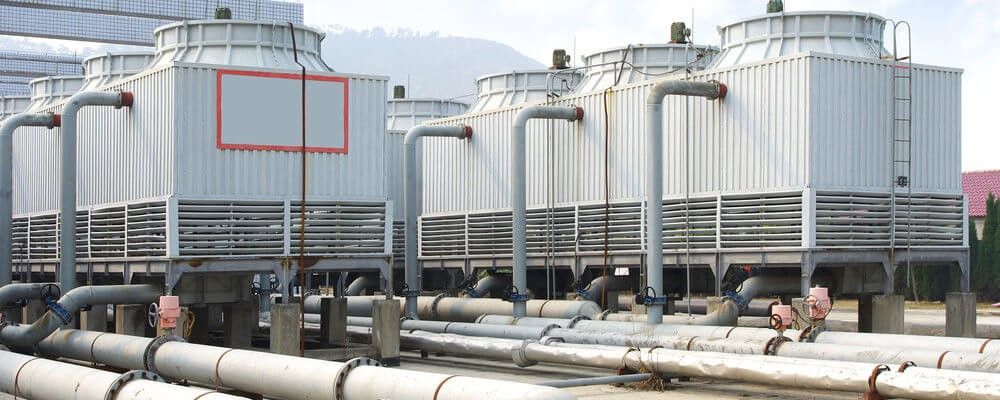
COOLING TOWER VS. EVAPORATIVE CONDENSER – TYPES OF EVAPORATIVE CONDENSER

The maintenance of stable process temperatures is critical to the success of many industrial and manufacturing processes. Industrial-scale temperature regulation cannot be achieved using conventional, portable cooling systems. In these instances where larger-scale cooling is desired, industrial capacity cooling systems are the most efficient way to maintain process temperatures at optimal ranges.
Depending on the manufacturer, cooling systems come installed with various condenser types including evaporative systems. This article will compare the various cooling towers and evaporative condensers available for industrial use and highlight the differences between both cooling systems.
What Is an Evaporative Condenser?
An evaporative condenser is a device that converts refrigerant contained within a closed circuit from a heated vapor to a cooled liquid form by the evaporation of water sprayed on the exterior surface of the refrigerant tubing. It is essentially a hybrid between an air-cooled condenser and a water-cooled condenser which uses the principles of heat rejection to follow an evaporative process.
The Function of the Condenser in a Chiller
The condenser component of an industrial chiller system functions as a heat transfer device between a process and its external environment.
Condensers can either be air-cooled, water-cooled or evaporative in design and function. Regardless of type, all condensers have a similar function: to transfer heat away from a refrigerant gas and thereby cool the required process or equipment.
Types of Evaporative Condensers
Evaporative condensers are divided into two main types
- Forced draft evaporative condensers
- Induced draft evaporative condensers
Forced Draft
Forced draft evaporative condensers pull air through the unit at its base, condenses it and releases it in a saturated form through an opening at the top of the cooling unit. This condenser type could either be a centrifugal fan-driven type or an axial type which is the most common set up available. The choice of forced draft condenser type depends on careful consideration of the features of each type and their efficiency in achieving cooling.
Axial Fan Design
This is the most common evaporative condenser in use industrially. It is mostly utilized in large scale industrial applications for rapid cooling. This forced draft condenser type has some advantages which include:
- Fan design that allows operation by a low horsepower motor
- Availability in a wide range of capacities suited to most industrial uses
- Easily accessible mechanical parts with a reduced cost of maintenance
Centrifugal Fan
Centrifugal fan models are utilized in cooling applications where sound may constitute a problem. These devices are generally quieter than their axial fan counterparts and as a result, centrifugal fan-type condensers can be installed in indoor locations. These evaporative condenser variants can be employed in halocarbon air-conditioning units and work quite efficiently.
Induced Draft
Induced draft evaporative condensers work by pulling air in the chiller environment through a condenser mounted at its base. The collected air is condensed and circulated to cool the associated process. Benefits of this condenser type include:
- Lower floor space needs
- Higher efficiency of cooling
- Fewer components than forced draft models (which implies lower maintenance costs)

Benefits of Evaporative Condensers
The advantages of opting for evaporative condensers are linked to process cost-savings. The main points are highlighted below:
- These condensers can efficiently run on less fan horsepower than their air-cooled chiller counterparts which drive down energy costs significantly.
- Installation and maintenance are easier as evaporative condenser cooling units operate with fewer components.
- Evaporative condenser units allow for smaller floor space installations.
Cooling Tower vs. Evaporative Condenser
The major difference between a cooling tower and an evaporative condenser chiller setup lies in the number of stages required to achieve their cooling effects.
For chiller systems that utilize a cooling tower, heat transfer from the cooling process involves two stages. The heat generated by an industrial or commercial process is first transferred to the circulating chiller fluid by the condenser unit before atmospheric heat rejection at the cooling tower. Thus, using chillers and cooling towers together require two levels of heat exchange.
On the other hand, chillers with evaporative condensers achieve similar results by a single heat rejection process which involves the evaporation of heated water from the external surface of the coolant tubing.
Cold Shot Chillers Has the Industrial Chillers You Need
For over three decades, Cold Shot Chillers has offered top-quality industrial chillers. Our priority remains the delivery of satisfactory customer experience to all clients through the provision of reliable process cooling solutions.
Check out the wide range of water-cooled chillers we have that are uniquely suited to your industrial and commercial purposes.
Contact us online today for more information about how we can help to achieve your process chilling needs.